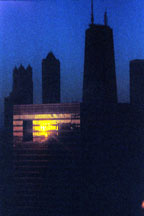

  |
||||
|
-
A glut of
hog-faced high-rises threaten to drag |
|
|||||||
|
If one day you found nothing but vast weed-strewn lots in their place, which of Chicago's skyscrapers would you miss most? The Sears Tower? The Wrigley Building? The Rookery? The Hancock? How many tall buildings, if they disappeared, would you call a major loss to the city? A dozen? Several dozen? Close to a hundred? Now think of the buildings you've seen go up over the past ten years, or that you see going up now. How many of these, if they disappeared, would you miss? Would you be able to name even one? After September 11, there were those quick to proclaim the era of tall
buildings over. Looking around at the Chicago skyline, punctuated by a
profusion of construction cranes, it's hard to see that. But the towers
now rising are the That many buildings are bad is no surprise-bad buildings, even in Chicago, are always the norm. But never before has mediocrity been embraced with such ardor. Chicago's collapse is not part of a universal trend. In other major cities architecture that matters is still being created. In Manhattan there's Renzo Piano's new headquarters for the New York Times, Donald Trump's surprisingly elegant new residential tower, and Raimund Abraham's narrow, razor-sharp Austrian Cultural Forum, to name just a few. In Los Angeles you'll find Frank Gehry's Walt Disney Concert Hall and Rafael Moneo's Cathedral of Our Lady of the Angels. Even in a city as small as Fort Worth, there's Tadao Ando's dazzling new Modern Art Museum. All of these projects have commanded attention and acclaim that have eluded any recent Chicago building. In Chicago, architecture of consequence-Rem Koolhaas's student center and Helmut Jahn's massive dorm complex at the Illinois Institute of Technology, or Rafael Vinoly's Graduate School of Business at the University of Chicago-has been relegated to the cloisters of academia, while the city center has become a tepid pot where all the ingredients appear to come from the generics aisle. The most prominent exception is the forthcoming Gehry band shell in Millennium Park, but its genesis points to a key reason for the decline: it was brought here not by a committee of bureaucrats or accountants but by the persistent work of one individual, enduring civic booster Cindy Pritzker. It's a reminder of the fundamental truth of architecture, recently expressed by Spanish architect Santiago Calatrava, whose new Milwaukee Art Museum has won international praise: "There is not a good project without a good client." No less now than in the time of the Medici, great art requires great patrons. Chicago's signature buildings arose from the egos of the men running the city's great corporations: Montgomery Ward's original Michigan Avenue tower, with its gilded, electrically lit nude of a weather vane; First National Bank Plaza (now Bank One Plaza), which bank chairman Gaylord Freeman rushed into construction before all the building permits could be secured; the Civic Opera Building, nicknamed "Insull's Throne" for Sam Insull, the utility tycoon who spent $24,000,000-in 1920s dollars-to erect it. But more and more of the great Chicago corporations are dead or dying, and the survivors are run by executives who come in and out as through a revolving door. Ward's, Amoco, First National Bank, Continental Bank, Morton Salt, and Field Enterprises have all been vanquished or assimilated by multinationals, and for the Chicago operations of these conglomerates distinguished architecture is neither required nor desired. Why make a long-term commitment when you can lease and, if things don't go as planned, just pack up and steal away? In this climate, Chicago has suffered a dramatic downsizing in corporate support for great architecture-Los Angeles gets a major concert hall from Frank Gehry, but Chicago settles for a footbridge and a canopy. We're in danger of falling to the status of a provincial city, where the approach to culture is to collect samples of the reigning brands: a Gehry here, a Koolhaas there, perhaps even a Piano in the parlor. It's the name, not the work, that's essential-an etching, a scribble, a band shell or a garden shed, any bit of bone will do. Lucien Lagrange is arguably the reigning monarch of Chicago architecture, and his success is far from undeserved. A product of McGill University and an alumnus of the pioneering postwar firm Skidmore Owings & Merrill, he's charming, modest, and gracious. His portfolio includes such important rescues and renovations as Union Station and the old Insurance Exchange Building (175 W. Jackson). He's behind a number of recent large-scale luxury high-rises, and is currently transforming the Carbon & Carbide Building into a new Hard Rock hotel. But although the splendid steel-and-glass Erie on the Park (500 W. Erie) suggests that his firm may not be entirely frozen in the past, Lagrange's specialty is a Disney-like denial that the 20th century ever took place: comforting classicist facades with surreal touches to accommodate the reality of commerce, like the 20-foot teddy-bear window in the faux-second-empire FAO Schwarz on Michigan Avenue or the huge bucktoothed grin of a picture window on the giant popsicle stick that is the Park Hyatt. He can be depended on not to challenge or offend: to have his name on
a luxury high-rise is an insurance policy that nothing will be seen that
hasn't been seen a thousand times before. He's a declared anti-Miesian,
pronouncing his contempt for those pompous glass boxes that turn their
backs to the street and offer nothing but empty lobbies and windswept
plazas where restaurants and shops should be. His points about the life
of the street are well-taken, his responses often imaginative and vital-at
175 W. Jackson, for example, he balances his a sensitive restoration of
the ravaged terra-cotta of the exterior with a wildly exuberant retooling
of the two internal light courts. We should be glad to have him-but for
his work to represent the best of the new is The Fall incarnate.
© Copyright 2003-2004 Lynn Becker All rights reserved.
|
||||||||